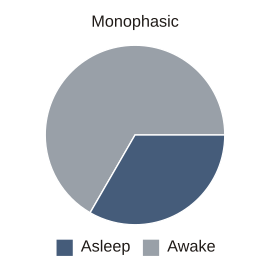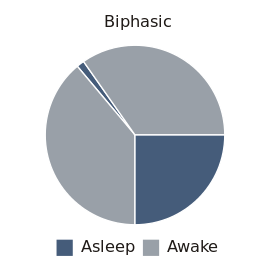Polyphasic sleep
Polyphasic sleep (or multi-phase sleep ) is a sleep pattern in which the need for sleep is divided into at least three sleeps per day. Such behavior is normal in newborns. In contrast, the sleep distribution between a night and a midday sleep is referred to as biphasic sleep and monophasic sleep is the form with only one sleep a day. Both are typical adult sleep patterns.
Sometimes the term is also listed as an artificially altered sleep rhythm for adults, which is supposed to make it possible to get by with relatively little sleep.
Comparison of sleep patterns
|
| Source: highexistence.com |
| Sleep pattern | total sleep time | REM phases number | method |
|---|---|---|---|
| Monophasic | ≈ 8.0 hours | 5 phases | 8 hours of main sleep phase with five REM phases |
| Divided up | ≈ 7 hours | 4 phases | 2 × 3.5 hours main sleep phase with 2 REM phases each |
| Biphasic (20-minute nap) | ≈ 6.3 hours | 5 phases | 6 hours of main sleep phase with four REM phases and a 20-minute “ daytime sleep ” with one REM phase |
| Biphasic (90-minute nap) | ≈ 6 hours | 4 phases | 4.5 hours of main sleep phase with three REM phases and a 90-minute sleep with one REM phase |
| Triphasic | ≈ 4.5 hours | 3 phases | three 1.5 hour naps, each with an REM phase |
| Everyman ("everyone"; with two naps) | 5.2 hours | 5 phases | 4.5 hours main sleep phase with three REM phases and two 20-minute day sleep phases with one REM phase each |
| Everyman ("everyone"; with three naps) | 4 hours | 5 phases | 3 hours main sleep phase with two REM phases and three 20-minute day sleep phases with one REM phase each |
| Everyman ("everyone"; with four to five naps) | ≈ 3 hours | 5-6 phases | 1.5 hours main sleep phase with an REM phase and four to five 20-minute daytime sleep phases with one REM phase each |
| Dymaxion | 2 hours | 4 phases | four 30 minute naps each with an REM phase (every 6 hours) |
| Uberman ("superman") | 2 hours | 6 phases | six 20 minute naps each with an REM phase (every 4 hours) |
According to the Süddeutscher Zeitung , the “Uberman” appeared on the Internet at the beginning of the millennium when an American woman under the pseudonym PureDoxyK reported that she had been practicing this sleep pattern for months as a college student . However, this pattern has two prerequisites: absolute discipline in keeping the naps and fitness in the approximately ten-day transition phase.
Influence on the circadian rhythm
The so-called circadian rhythm (also: circadian rhythm ) in chronobiology summarizes the endogenous (internal) rhythms that have a period length of around 24 hours and, in many living beings, have a great influence on the functions of the organism. As such, there is a possible link to the human sleep rhythm. A sleep pattern that deviates significantly from the typical 8-hour cycle has long been assumed to be disruptive to a physiological expression of the circadian rhythm. Investigations by Zulley and Carr from the Max Planck Institute of Psychiatry in Munich in 1991 showed, however, that the circadian rhythm was not coupled to a biphasic sleep pattern.
Compliance with sleeping times
Polyphasic sleep requires strict adherence to sleep times. Sleep times must be evenly distributed and strictly adhered to, as oversleeping or skipping sleep times results in a drastic decrease in performance. This also leads to a drop in performance in monophasic sleep, although this is usually not quite as drastic as in polyphasic sleep.
A particular problem here is that sleeping places have to be found regularly in which sleep is not disturbed. This is a hindrance for longer trips and activities. Working life is also mostly adapted to the monophasic sleep pattern, which can lead to collisions.
These effects are stronger, the more sleep phases the respective sleep pattern provides.
Another obstacle is the familiarization phase, which takes about two to three weeks.
Supporters of polyphasic sleep usually end their sleep phases with an alarm clock. In contrast, practitioners of two-phase sleep (night sleep and afternoon nap) often wake up without an alarm clock.
functionality
The usual night sleep of approx. 8 hours is divided into a total of 5 sleep phases of approx. 90 minutes each. REM sleep, which is valuable for mental recovery, is reached towards the end of a sleep phase .
“Polyphasic sleep” aims to achieve as much REM sleep as possible with as little total sleep as possible. Basically, this is nothing more than chaining several power naps together .
However, during the acclimatization period of approx. 10 days, the part of the REM phase z. For example, with Uberman it is increased within 20 minutes so that with a total of 2 hours of sleep one achieves a total duration of REM sleep equivalent to the normal 8-hour night sleep. The so-called "REM rebound" effect plays a role here.
application
Polyphasic sleep is used when sleep times have to be minimized over a longer period of time. This is about with athletes, z. B. the multi-day RAAM bike race and circumnavigators , the case.
Alternatives
In professions where a long waking time is required - for example in the military and doctors - polyphasic sleep is usually not used. Instead, a waking period takes place in one piece and is balanced out by an extended main sleep phase.
See also
literature
- Claudio Stampi (Ed.): Why we nap: evolution, chronobiology, and functions of polyphasic and ultrashort sleep . Foreword by Jürgan Aschoff. Birkhäuser, Boston 1992, ISBN 0-8176-3462-2 (English).
Individual evidence
- ↑ Jordan Lejuwaan: Alternative Sleep Cycles: You Don't Really Need 6-8 Hours! ( English ) highexistence.com. Retrieved April 2, 2020.
- ↑ Berit Uhlmann: Schlafes Brüder. In: Süddeutsche Zeitung . May 17, 2010, accessed April 3, 2020 .
- ^ J Zulley, D. Carr: Forced splitting of human sleep in free-running rhythms. In: J Sleep Res . No. 1 (2) , June 1992, pp. 108-111 ( wiley.com ).




